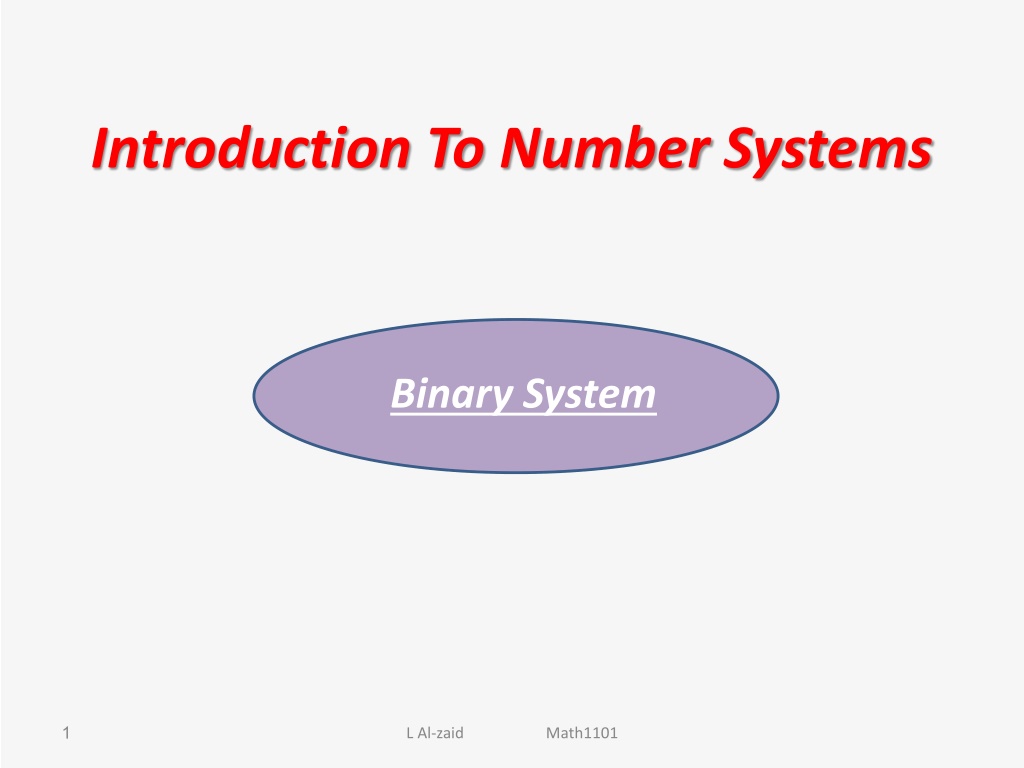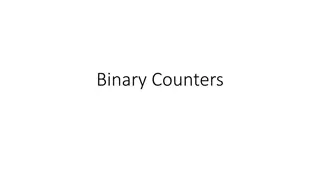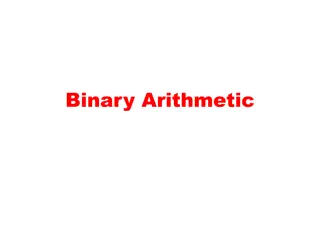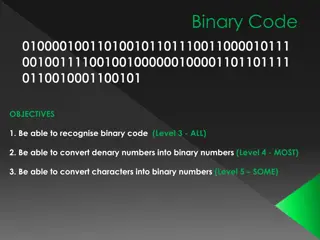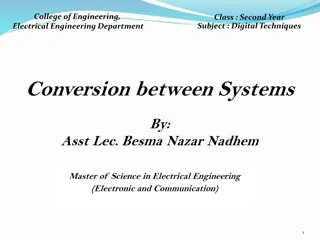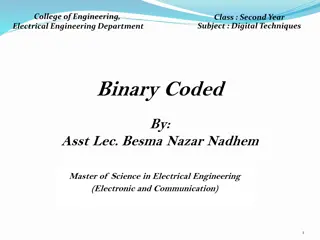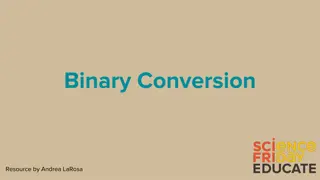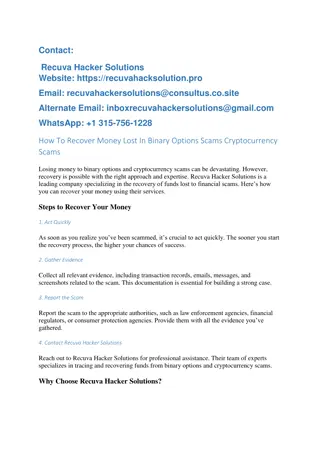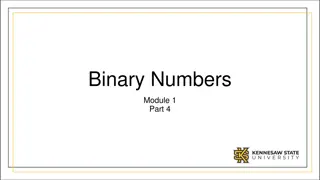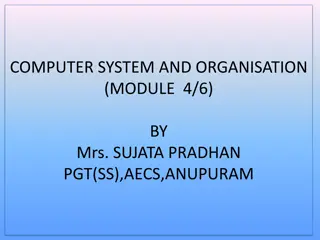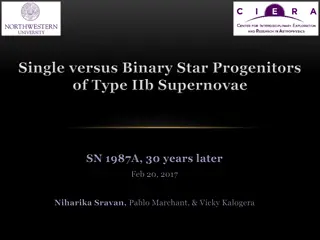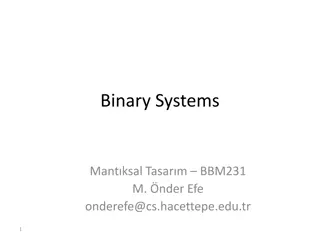Exploring the Binary Number System in Mathematics
Delve into the intricacies of the binary number system with this comprehensive guide. Learn how binary numbers are formed, and master the conversion techniques between binary and decimal numbers. Discover the fascinating world of binary fractions and the algorithms for converting decimal numbers to binary equivalents. Uncover the step-by-step processes involved in these conversions through detailed examples and visual aids.
Download Presentation

Please find below an Image/Link to download the presentation.
The content on the website is provided AS IS for your information and personal use only. It may not be sold, licensed, or shared on other websites without obtaining consent from the author. Download presentation by click this link. If you encounter any issues during the download, it is possible that the publisher has removed the file from their server.
E N D
Presentation Transcript
Introduction To Number Systems Binary System 1 L Al-zaid Math1101
Binary System The binary system is a different number system. The coefficients of the binary numbers system have only two possible values: 0 or 1. Each coefficient d is multiplied by 2n. For example, the decimal equivalent of the binary number 11010.11 is 26.75, as shown from the multiplication of the coefficients by powers of 2: 1x24+ 1x23+ 0x22+ 1x21+ 0x20+ 1x2-1+ 1x2-2= 26.75 the digits in a binary number are called bits. 2 L Al-zaid Math1101
Binary to Decimal Conversion A binary number can be converted to decimal by forming the sum of powers of 2 of those coefficients whose value is 1. Example 2 Convert the binary number (1101001)2 to decimal. Solution: (1101001)2 = 3 L Al-zaid Math1101
Binary Fractions Example3: Convert the (110.001)2to decimal. Solution: (110.001)2 = ------------------------------------------ Example 4 Convert (0.11101)2to decimal. Solution: (0.11101)2 = = = 4 L Al-zaid Math1101
Decimal to Binary Conversion Algorithm 1 To convert from a base-10 integer numeral to its base-2 (binary) equivalent, the number is divided by two, and the remainder is the least-significant bit. The (integer) result is again divided by two, its remainder is the next least significant bit. This process repeats until the quotient becomes zero. 5 L Al-zaid Math1101
Decimal to Binary Conversion Example 5 Convert 2310to binary number. Solution: Quotient Remainder 1. 2. 3. 4. 5. 6. 7. 23 2 = 11 2 = 5 2 = 2 2 = 1 2 = 0 2 = 0 2 = sign bit The answer is found by reading "up" from the bottom. Therefore, 2310= 6 L Al-zaid Math1101
Decimal to Binary Conversion Example 6: Convert 4610to base 2. Solution: Quotient Remainder 1. 2. 3. 4. 5. 6. 7. 46 2 = 23 2 = 11 2 = 5 2 = 2 2 = 1 2 = 0 2 = sign bit Therefore, 4610= 7 L Al-zaid Math1101
Decimal Fractions to Binary Fractions Conversions To convert the fractional part successive multiplications are done instead of divisions. In each case the remaining fractional part is used in the succeeding multiplication 8 L Al-zaid Math1101
Decimal Fractions to Binary Fractions Conversions Example 7 Convert the decimal fraction 0.5937510to binary fraction. Solution: To convert the fractional part (0.59375)10, successive multiplications are done instead of divisions. In each case the remaining fractional part is used in the succeeding multiplication Integer Fraction 1. 0.59375 x 2 = 2. 0.1875 x 2 = 3. 0.375 x 2 = 4. 0.75 x 2 = 5. 0.5 x 2 = Therefore 0.5937510= 9 L Al-zaid Math1101
Decimal to Binary Conversion Example 8 Convert 46.5937510to base 2. Solution: First, convert the whole number (46) using the previous method. 4610= 0010 11102 Next, convert the fractional part (0.59375), also use the previous method. 0.5937510= 0.100112 Therefore, 46.5937510= 0010 1110.100112 10 L Al-zaid Math1101
Arithmetic in the Binary System 11 L Al-zaid Math1101
Binary Addition The process for adding binary numbers is the same in any number system, except that you must be aware of when (and what) to carry . In the decimal system, a carry occurs when the sum of 2 digits is 10 or more. For example, In binary, a carry occurs when the sum of 2 binary digits is 2 or more. This leaves only four possibilities: 0 + 0 = 02 0 + 1 = 12 1 + 1 = 102(therefore, 0 with a carry) 1 + 1 + 1 = 112(therefore, 1 with a carry) 12 L Al-zaid Math1101
Example9: Add the binary numbers 0011 00102+ 0011 01112: Solution: Addition table + 0 1 0 0 1 1 1 10 13 L Al-zaid Math1101
Example10: Add the binary numbers 1011.012+11.0112 Solution: Addition table + 0 1 0 0 1 1 1 10 14 L Al-zaid Math1101
Binary Subtraction For binary subtraction, there are four facts instead of one hundred: 15 L Al-zaid Math1101
Example 11: Subtract: 10101.101_1011.11 Solution: Step 1: 1 0 = 1. Step 5: 1 1 = 0. Step2: Borrow to make 10 1 = 1. Step 6: 0 0 = 0. Step3: Borrow to make 10 1 = 1. Step7: Borrow to make 10 1 = 1. Step 4: Cascaded borrow to make 10 1 = 1. 16 L Al-zaid Math1101
Checking the Answer You can check the answer in a few ways. One way is to add the result (1001.111) to the subtrahend (1011.11), and check that that answer matches the minuend (10101.101): 17 L Al-zaid Math1101
Binary Multiplication Binary multiplication uses the same algorithm as in decimal, but uses just three order- independent facts: 0 x 0 = 0, 1 x 0 = 0, 1 x 1 = 1 18 L Al-zaid Math1101
Binary Multiplication Example 12: Multiply 1011.01 x 110.1 Solution: 1 1 1 1 10 1 1001001.001 19 L Al-zaid Math1101
Homework All Exercises Page 10 20 L Al-zaid Math1101
